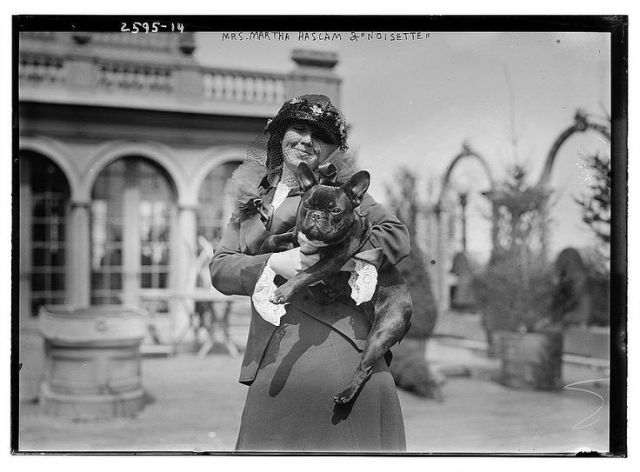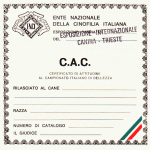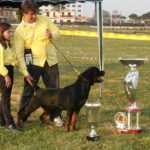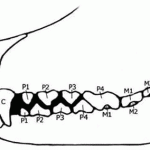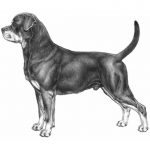The mastiffs are dogs of strong muscles, a strongly developed skull, from short snout and the powerful jaws. Their morforlogia varies as a function of their size and their format. The French Bulldog is considered a small mastiff. There are few fossils to locate with exactness the cradle of races molossoidi. Some Assyrian reliefs (circa 900 A.C. years) rapresentano dogs of this type, with strong similarities with the Tibetan dog. According to P. Megna, Marco Polo, during his stay at the court in Great Moghol 1271, He writes the existence of large-sized dogs: "He saw some that were the size of a donkey". These dogs ferocious character, powerful and dedicated to fighting followed the hordes of warriors who moved from East to West in search of new territories. The primitive type has undergone many changes during these trips, It is subjected to various influences such as climate, food resources and intersections with various local breeds.
Dating the landing of these mastiffs on British soil remains uncertain. It's supposed to have arrived with the Roman legionaries during invasions, but some of the writings of Greek and Roman historians of the first century B.C.. show the presence of copies "pugnaces Britaniae" (British Bellicosi) since the relations with the Phoenician traders.
These dogs, used as real weapons to induce terror among the population to be conquered, They were also exploited for hunting wild game of great size and also for fun, making them participate in fights between animals, often the most dangerous as bears, lions or bulls, as they used to demonstrate an impressive courage stimulating the admiration of the spectators. According to St. John Cooper, these "meetings" barbarians were kept in the United Kingdom until 1835, date on which the law forbade the fighting with the bulls, between bears and dogs, even if they were illegally continued for at least one ciquantina years yet.
Often used to accompany the cattle to the slaughter, they were called "bolddoge" or "banddoge" around the sixteenth century, name that gradually turn into bull-dog, bull dog.
Until the second half of the nineteenth century the mastiffs have known a number of variations in particular in their size. The weaker puppies were left out and collected as a part of the population who could not afford dog so valuable and so "dear" to maintain and were then paired with local actors, particolarli in the usually very tenacious terrier type dogs to be used in the hunt for rodents. This reduction in size has greatly developed due to the end of the fighting and, as a result of these various crossings, it is very likely that some people are born with straight ears.
The cousins: Bulldog, Mastiffs and other small mastiffs
Next to the Mastiff, was big and heavy, there is a Bulldog, smaller but brave altrattanto, with a weight over the 40 free. The Bulldog was also reduced after several crossings in size and in weight. Manchester canine Nell'esposizioni of 1864 he was born in 1865, Bulldogs competed in two classes, below and above the 12 libre and smaller were called "Toy Bulldog". And 'necessary to clarify that the English Bulldog back then did not look for anything in the English bulldog we know today, less massive, with a smaller head and limbs straight, but much closer to the French Bulldog, with curved ears or clamshell.

The Toy Bulldogs were working dogs, excellent hunters of rodents or other pests in homes, laboratories and workshops, but also excellent companions of faithful life and compact. And so followed the lace merchants that Nottingham, fleeing for economic crisis, They had taken refuge in the north of France. And 'likely they interbred with local dogs, Doguins (sort of Dogue de Bordeaux small), Terriers and Pugs also. The French have rapidly adopted them, generating an export flow from England, with the great pleasure of the English merchants sbarazzari of these dogs always the most ignored by the British.
The difficult start breeding

The French breeders were few, from modest, but determined to establish the characteristics of the breed; their main concern was to select, not without difficulty and despite the criticism of dog lovers, dogs with erect ears and shorter muzzle can. For a time, could be seen competing on the ring is the subject erect ears that subjects the clamshell ears.
In 1893 M.G. Krehl, a British breeder, He imported from France a small group of French Bulldog, already known as "French Toy Bulldog" to present the exhibition of the Kennel Club and so began the controversy about the authorship of the breed of the French Bulldog.
French or English?
Dick Harrison, which began before Krehl to import French subjects in Grand-Britain, He argued that the French bulldog descended from British subjects and not from indigenous dogs and esteemed in all logic that the French would not have exposed a group of French Bulldog to the famous "Jardins d'Acclimatation" in the midst of rare animals, if they had been French race. According to Mrs. de Comminges, instead, This small group of Toy Bulldog had landed from England for hunting rate by Count The Coulteux de Caumont and Mr.. Geoffroy, his friend. From 1867 until the 1895 He would then riprotto without any outside interference.
The English Bulldog Club then began to refuse enrollment of the French Toy Bulldog Stud Book (English Book of Origins), with the excuse that the French had not maintained the purity of the breed, by changing the carriage of ears, and then accept them with both types of ears from 1899. The Toy Bulldog Club was founded in 1898.
He Terrier Boule
Another argument advanced recently documented by the famous French cynologist Pierre Megnin would like the French Bulldog was the result of crossbreeding between the smallest "Bulldog de Bordeaux or the Midi" and the Dogue de Bordeaux. These intersections would give birth to "Doguin", also said Roquet, famous dog used by the Parisian butchers. Just in Paris on our Roquet it would be mixed with those other dogs used for hunting mice, little ones, muscled from short snout, called "Terriers-Boules" from one of the founders of the breed, Mr.. Roger.
Beyond these arguments, now difficult to verify, But it is that our French bulldog is the result of crossbreeding, a po 'forfuiti, between the Toy Bulldog came from Britain and the various local dogs. If the British have provided the genetic source, we can say that the French have created and stabilized.

A bit of history
1880: an important date in the history of the French Bulldog.
The history of the French Bulldog began very modestly: It is first and foremost a working dog, a butcher's dog, not appreciated by the official dog. These small farmers share a passion for their dogs, they work with each other without worrying neither fashion nor criticism. Of different horizons, from the butcher to the wine merchant, from horse trader to "madam" of brothels, meet to compare the merits of their dogs, program pairs and groped to create with the experience and the various morphological tentative a conductor wire. They are content to create in 1880 a club of friends (She tells you something? Editor's note) with only forty-seven members. Eight years pass before the club to give itself a constitution and that it is called a draft Standard, with a scale of ratings for judgments. The two types of ears are accepted.
A fashion dog

Americans traveling in France begin to be interested in this unique creature with ears pricked. One of the first amateur race, Mr.. Phelps in Boston, He falls in love to the point of bringing with him on his return to America in 1896 Some examples of small "boules" to start a farm and always in 1896 Boules arouse the enthusiasm and curiosity to Westminster Show. Fashion is launched immediately.
The breeders of these little dogs that nobody cares in France see land richissimi Americans ready to pay high prices to acquire their litters. Prices go up from 650 francs of that time paid by Phelps up to 6.000 francs paid by the Grand Duke Paul, nephew Tsar Nicholas.
In France
This funky little dog who accompanies the coachmen out from its environment and conquer some of the quirky world of artists who attend the premises a little 'shady, brothels and ladies from the slight moral. Gordon Bennet, wealthy American patron, founder of the New Herald in Yord 1835, falls in love with this creation canine and will engage with its worldly relations to gain recognition for the breed of the French Bulldog from official institutions. A New Club, the Meeting of Amateurs of French Bulldog, born in 1898 under the patronage of the Central Canine Society (French Enci, ed).

The President is right Mr.. Bennet; are part of this association the humble origins farmers and the French aristocracy, as the Prince of Wagram, il Barone Carayon Tower, Count de Montauzon and others who share the passion of Mr.. Bennet. A precise standards is drawn: straight ears will be the only authorized.
This success occurs despite repeated opposition from the world of French dog world, in particular from cinologo Paul Megnin (son of Pierre cynologist Megnin), that in 1904 writes: "How is it that, seeing these heads piutosto horrific and these flat faces, these noses, this protruding jaw, nature has been able to create an animal so ugly?”, to conclude "the bulldog is not, properly speaking, a race, but rather a congenital abnormality ".
International success

Our Boule knows his first real international success in the United States of America, where farmers import from France first and then across Europe, in gold prices the best subjects, trying to respect the Standard and doing a very rigorous selection process.
England adopts a standard for French bulldog only 1911, after the birth of a breed club 9 years ago, in 1902.
Just as in Europe, the early years of the twentieth century Burgo formed National Club, in Germany (1909), in Austria, in Switzerland (1924) and Belgium (1937). The landing of the French Bulldog in ordierni Eastern Europe is due to the Romanov imperial family known to have had some specimens of French Bulldog to the Court of the Tsar, at which France and the French language were very fashionable.
THE HISTORY OF BULLDOG
Related Posts
NEWS MOST 'INTERESTING
on our blog all the most interesting news about the world of dog world. If you are interested in some information about expo, dog health, breeding Dell'Antico Warrior, you can not find. Contact us we shall be glad to publish some post about it.


